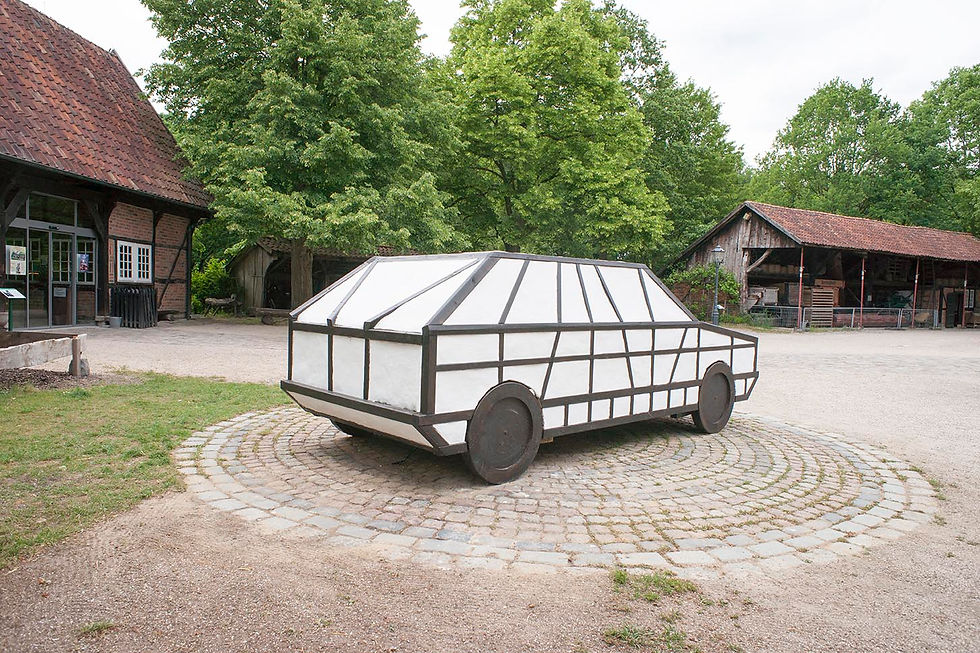volksfachwerkwagen, 2019


Lehm, Stroh, Sand, Holz, Kalkputz, Kalkfarbe, Licht, elektrische Verdrahtung; Masse: Golf I
Kunst im öffentlichen Raum - Freilichtmuseum Münster
Ein Fachwerkhaus aus Lehm, Stroh, Sand, Holz in der Form eines Volkswagens Golf I ist im Hof des Mühlenhof - Freilichtmuseums auf einer kreisförmigen Plattform aus Kopfsteinpflaster eingeparkt. Wenn es dämmert, sieht man ein warmleuchtendes Licht, das im Inneren des mobilen “Hauses” erstrahlt. Ein Haus in der Form eines Autos.
Die Arbeit bezieht sich auf die ursprüngliche Funktion des Autos. Ein Automobil als temporärer Wohnraum, welcher die notwendigen Elemente und Form für eine entsprechende Lebensqualität nach Weeber und Bosch wie z.B. Schutzfunktion, Bequemlichkeit, Temperaturregulation besitzt, hat Aspekte die eine vorstellbare Kraft haben, ein Haus zu sein. Durch Entfunktionalisierung bzw. Funktionsveränderung dank einer Intermedialität entsteht eine neue Betrachtungsweise, die unsere Wahrnehmung auf eine neue Stufe hebt. Die Verschmelzung des VW Golf, eine der ersten industriellen Errungenschaften und sozialen Projekte für einen bezahlbaren und sparsamen Wagen mit einem frühgeschichtlichen Bauwerk, bringt den neuen Inhalt hervor.
Die Arbeit verweist aber nicht nur auf die aktuelle Realität des Mobilitätwachstums. Auch auf die Geschichte, die hinter den beiden Begriffen, Fachwerkhaus und Volkswagen steckt, wird verwiesen, auf die Komplexität der Relationen zwischen dem Drang nach Freiheit und dem gleichzeitigen Bedürfnis nach einer kollektiven Zugehörigkeit. Als Symbole der kollektiven Identität spielen Volksmuseen, das Fachwerkhaus, Volkswagen eine bedeutende Rolle. Was heißt aber sich mit einem bestimmten Ort, Objekt oder einer Marke zu identifizieren? Die Arbeit hinterfragt auch diese Gedankenkonstruktionen. Durch die hybride Verbindung entsteht ein Paradoxon: Ein dynamisches Objekt, eine “Freiheitsmaschine” erzeugt die statische Funktion eines Hauses.
A half-timbered house made of clay, straw, sand, and wood in the shape of a Volkswagen Golf I is parked in the courtyard of the Mühlenhof Open-Air Museum on a circular platform made of cobblestones. As dusk falls, a warm glow emanates from the interior of the mobile "house." A house in the form of a car. The work refers to the original function of the car. An automobile as a temporary living space, possessing the necessary elements and form for a suitable quality of life according to Weeber and Bosch, such as protective function, comfort, temperature regulation, has aspects that have a conceivable force to be a house. Through de-functionalization or functional transformation thanks to intermediality, a new perspective emerges, elevating our perception to a new level. The fusion of the VW Golf, one of the first industrial achievements and social projects for an affordable and economical car, with an early historical building brings forth the new content. However, the work not only points to the current reality of the growth in mobility. It also refers to the history behind the two concepts, half-timbered house and Volkswagen, addressing the complexity of the relationships between the desire for freedom and the simultaneous need for collective belonging. As symbols of collective identity, folk museums, the half-timbered house, and Volkswagen play a significant role. But what does it mean to identify with a specific place, object, or brand? The work also questions these thought constructions. Through the hybrid connection, a paradox arises: a dynamic object, a "freedom machine," generates the static function of a house.










